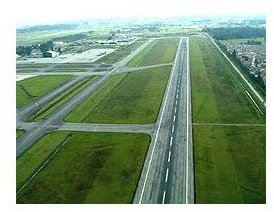Airport Runway Safety Programs - Preventing Bird Strikes and Establishing the Runway Safety Area
Bird Strikes
A major concern for airplanes during takeoff and landing on runways is the possible collision between the plane and birds. While the incidents are relatively common, the fact gained extra attention following the crash of US Airways Flight 1549, an Airbus A320, into the Hudson River in early 2009. Airports have installed a variety of airport runway safety programs designed to mitigate the risk to planes taking off and landing.
Many airports plant poisonous grass and plants around the vicinity of the airport, which diminish the amount of insects in the area, thereby not attracting birds. The facilities also grow the grass to roughly a foot tall, a principle that prevents certain birds from landing in the area. Specialty programs are used in areas where the bird population is high. Some airports simply employ personnel with shotguns, designed to kill and scare off large amounts of birds. Others use falconers who send out birds of prey to kill smaller species. However, the most common method of preventing runway bird strikes is to simply play recordings of predators over speakers.
Lighting and Markings
Since the beginning of the aviation industry, pilots and ground personnel have utilized a system of lights and markings to make sure planes are guided to the correct location. Modern airport runway safety programs make use of international regulations and stipulations that mandate certain criteria. Lights of different colors are placed along the edges, either end and along the center line of the runway in an effort to keep planes on track for landing and takeoff. There are also additional lights placed on the areas designed for touchdown and takeoff, helping the pilot know when to perform certain actions.
Depending on the size and status of the runway, certain markings are placed on or alongside the strip designed to guide the pilot to the correct area for a safe takeoff and landing. The most basic markings indicate the ends of the runway, the touchdown location, a center line and fixed distance markers. Others may include aiming points and horizontal and vertical guides to match instrumentation.
Above right: Runway diagram. (Supplied by Cmprince at Wikimedia Commons; GNU Free Documentation License; https://upload.wikimedia.org/wikipedia/commons/9/90/RunwayDiagram.png)
Runway Safety Area

One of the most important airport runway safety programs in place around the world is the principle of a runway safety area. This is a certain distance around the runway established as a precautionary measure in the event of problems with airplane takeoffs or landings. Over the years, these dimensions have increased with the increased size and quantity of aircraft. According to the US Federal Aviation Administration, modern recommendations, the runway safety area encompasses a distance of 500 feet in width and 1000 feet from each end.
Above left: Runway. (Supplied by Jun 98 5 at Wikimedia Commons; GNU Free Documentation License; https://upload.wikimedia.org/wikipedia/commons/0/0b/Bogrunway.JPG)
System of Runway Safety Protocol
Standard operating procedure at airports around the world have established certain protocols to determine what type of incident occurs on a runway when an accident happens. Each definition makes reporting, incident management and investigation easier for officials. These incidents are officially referred to as runway events.
A runway incursion happens when a second plane somehow enters the runway safety area. This can occur if a plane enters the runway on the ground or from the air. Usually this involves pilot or air traffic controller error. In the event a single aircraft uses the wrong runway or taxiway, the incident is considered runway confusion.
A runway excursion is an event in which a single aircraft exits the runway in an unwanted fashion. Sometimes, a pilot may take off too early or the aircraft may exit the runway on the ground from malfunction or poor weather conditions. Overruns, in which the aircraft does not take off in time before the end of the runway is reached, is also an example of a runway excursion. These are the most common types of runway accidents, accounting for 96 percent of accidents between 1995 and 2007 according to the Flight Safety Foundation.
In the Event of an Emergency
In order to maintain the proper standards for all of the airport runway safety programs in place, a number of individuals and groups must be on hand at all times to establish, implement and monitor the proper standards. When a runway event occurs, the airport has its own fire department, first responders and security personnel. These groups are equipped with devices that can place flame retardant material on the runway, put out fires and evacuate passengers in the event of an emergency. Other personnel are hired specifically to keep conditions on the runway safe for takeoffs and landing, such as waterproofing and snow removal.
In all, airport runway safety programs are used in a variety of capacities to keep the airline industry functioning and maintain one of the safest ways to travel.
Resources
FAA Runway Safety Programs: https://www.faa.gov/airports/runway_safety/
NBAA Runway Safety: https://www.nbaa.org/ops/safety/runway/
This post is part of the series: How Airlines Maintain Runway Safety
Runway safety is one of the most important aspects in safe airline practices. Alaska Airlines helped establish the current procedures for airline runway safety.
